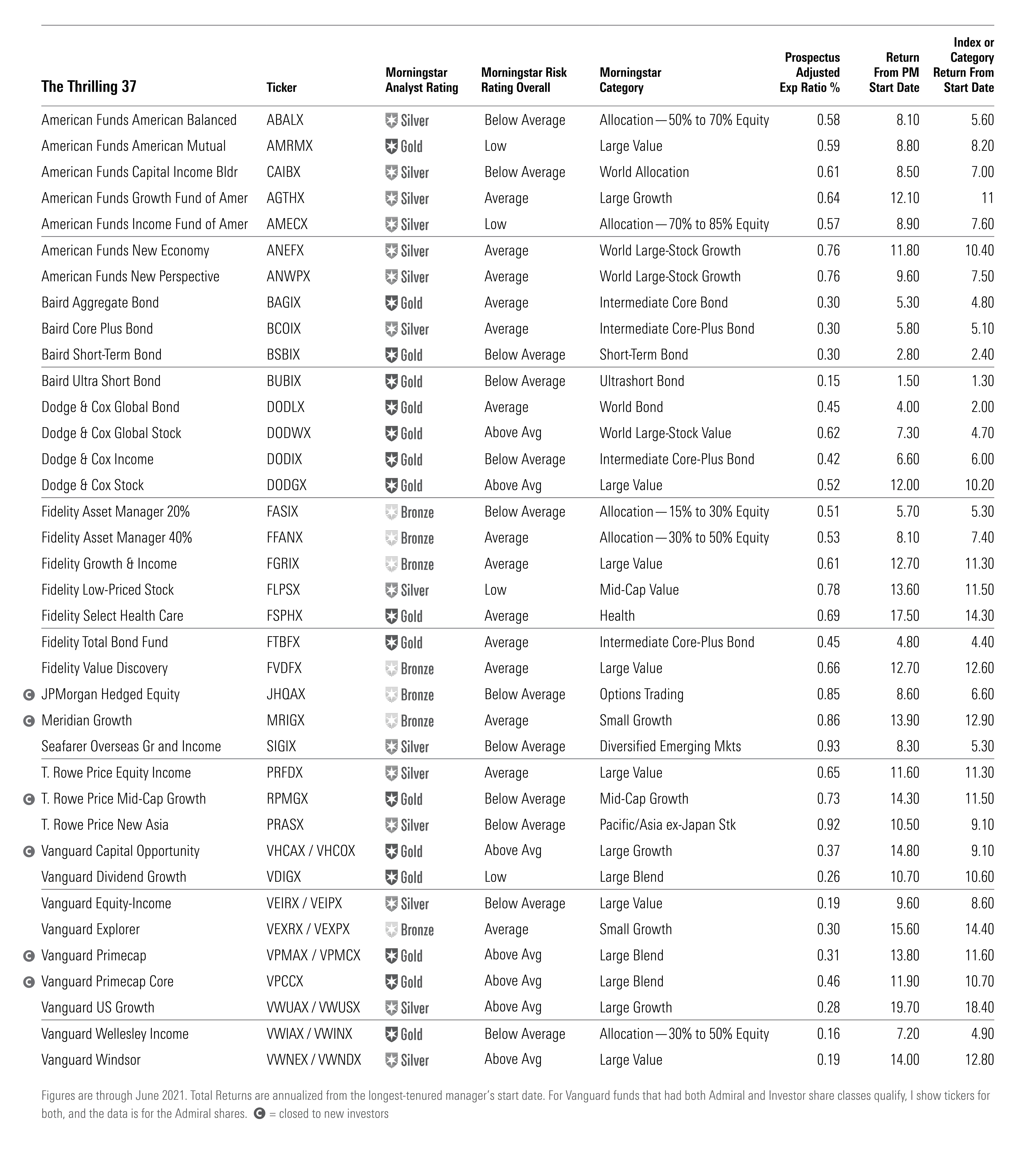The Thrilling 37
These are the funds that passed our rigorous screens.

This article was originally published in the July issue of FundInvestor. Download a complimentary copy of FundInvestor by visiting the website. The only update was in the Vanguard Equity-Income paragraph where a manager transition is in the works.
It’s time to unveil the Thrilling 37. It’s an extremely selective annual list focused on the most important data points for achieving investment success. With more than 8,000 funds out there, you can be super choosy. So, I raise the bar on some crucial metrics, and each year, somewhere between 20 and 50 funds pop out. I don’t make any changes to the metrics, so the results are simply the output of screens and not influenced by my opinion.
The whole point is to use the data points most closely linked with strong performance. Here are the tests that each fund must pass.
- Expense ratio in the category's cheapest quintile.
- Manager investment of more than $1 million in the fund (the top rung of the investment ranges reported in SEC filings).
- Morningstar Risk rating below the High level.
- Morningstar Analyst Rating of Bronze or higher.
- Parent rating better than Average.
- Returns greater than the fund's Morningstar Category benchmark over the manager's tenure for a minimum of five years. In the case of allocation funds, I also used category averages because benchmarks are often pure equity or bond and therefore not a good test.
- Must be a share class accessible to individual investors with a minimum investment no greater than $50,000.
- No funds of funds.
For the expense ratio, I use the prospectus adjusted expense ratio. This figure excludes costs that are not collected as fees by the manager, such as leverage, shorting costs, or brokerage commissions. That it gives us a true apples-to-apples comparison.
That’s not to suggest that those kinds of costs don’t matter. They do matter, but, as they are not collected by the fund company and tend to bounce around, they are more noise than signal.
The Morningstar Risk measure is the risk adjustment used for the Morningstar Rating for funds. It is based on the utility theory of risk and penalizes downside volatility more than upside. I throw out high-risk funds because our studies of Morningstar Investor Returns suggest that people have a harder time using high-risk funds well.
I have not excluded funds closed to new investors. The people who bought them in the past want to know if they still qualify. I have marked those funds as closed in the table. You'll notice that some institutional share classes made the test. That's because they are available for a minimum of $50,000 or less. Also, there are A shares--yes, a full load can undermine that fee edge, but all the listed funds also are available for no-load. (PDF available here.)

There From the Start
My first list came out in April 2012. That 18 funds from the original Fantastic 46 are still on the list today speaks to the staying power of these funds and the tests that they passed. Because I don’t have space to write about all 37, I’ll focus on those 18 funds.
Allocation All three of our enduring allocation funds hail from American Funds. Their focus on the long game is really borne out here. The firm's formula is to have seasoned managers, outstanding analysts, a simple strategy, and low costs. American is particularly good at income-oriented funds like American Funds Capital Income Builder CAIBX and American Funds Income Fund of America AMECX because they are savvy investors in dividends but also responsible enough to avoid big gambles that boost yield. American Funds Capital Income Builder, a world-allocation fund, really showcases the firm's depth. The fund is 70% equity, and the equities are an even split between foreign and domestic stocks. The fund tilts to value to pick up dividends, though that means it lagged until late 2020 when value began to outperform growth.
American Funds Income Fund of America AMECX is in our allocation--70% to 85% equity category, and it, too, has lagged a bit because of its dividend stock tilt. Hilda Applbaum makes modest asset mix adjustments based on the apparent opportunities. The fund is limited to stocks with a forward dividend yield of at least 3%, which keeps it grounded in value, but management doesn’t chase the highest-yielding stocks, which also come with the highest risks. From Dina Perry’s 1992 start date, the fund’s annualized 8.9% gain has topped the category’s 7.6% return.
American Funds American Balanced ABALX is also an appealing mix of stocks and bonds that quietly gets investors to their goals. Underpinning these three Silver-rated funds are low fees whose benefits show up in long-term compounding.
Bonds Dodge & Cox Income DODIX and Fidelity Total Bond Fund FTBFX have long made the most of their strategies by sound issue selection and robust risk controls that keep the funds from getting too aggressive. Both are Gold-rated and super cheap funds with very experienced leaders.
Dodge & Cox went on offense in March 2020 when credit sold off, dramatically raising corporate exposure by month-end to 38% from 34% and up to 45% in June. It was a good call as the market later rallied. Fidelity’s Ford O’Neil likewise added corporate exposure amid the stark sell-off in 2020.
International Equity American Funds New Economy ANEFX and American Funds New Perspective ANWPX have been quite rewarding for shareholders. American Funds New Economy has 10- and 15-year annualized gains of 14.7% and 11.6%, respectively. American Funds New Perspective is a touch behind at 12.9% and 10.6%. American Funds New Economy has a more pronounced U.S. equity tilt and more exposure to mid-caps and the smaller end of large caps. American Funds New Perspective, with 4 times the asset base, naturally is focused on big blue chips and has a smaller U.S. weighting at 52% of assets.
U.S. Equity Silver-rated American Funds Growth Fund of America AGTHX is a solid core holding that sticks to very large growth names.
Gold-rated American Funds American Mutual AMRMX is a resilient income-oriented value fund. It tends to hold up well in down markets while producing a decent yield.
Dodge & Cox Stock DODGX is an outstanding value fund. The Gold-rated fund has some of the best managers and analysts around. It does require patience, however, as it has suffered some serious turbulence along the way.
Fidelity Low-Priced Stock FLPSX is another welcome sight as Joel Tillinghast has diligently done a remarkable job of stock selection even with a very large asset base. Very few could have pulled it off, and yet he just keeps doing it year after year.
Silver-rated T. Rowe Price Equity Income PRFDX is an appealingly steady fund run by John Linehan. It’s a pretty straightforward equity-income strategy, but Linehan and T. Rowe’s outstanding analysts make it a cut above.
T. Rowe Price Mid-Cap Growth RPMGX also feels like an old friend. Brian Berghuis been remarkably consistent for legions of shareholders. Maintaining an edge in the rapidly changing growth arena is not easy. But Berghuis and T. Rowe’s analysts succeed through fundamental research that keeps them a step ahead.
Primecap’s three funds subadvised for Vanguard were on my first list, and they are still going strong. The funds’ relative underweighting of FAANGs (Facebook FB, Apple AAPL, Amazon.com AMZN, Netflix NFLX, and Google [Alphabet] GOOGL) and greater exposure to blend stocks held back returns in 2020, but they’ve since come back strong and boast solid performance. Primecap aims to hire the smartest people and let them figure the rest out. It’s worked well, and the funds’ very low fees provide a boost relative to most competitors. (The three funds it runs under the Primecap label just missed the cut because of either fees or risk.)
Vanguard Dividend Growth VDIGX is another example of the power of Vanguard’s low costs, a great strategy, and a skilled manager. Wellington’s Donald Kilbride has produced solid returns with great downside protection. The process of finding companies that can grow their dividends means Kilbride is buying companies with sustainable growth and low levels of debt. Those are the sort of companies that usually hold up well in a bear market.
Vanguard Equity Income VEIRX is a solid fund that holds its appeal even with the pending retirement of Michael Reckmeyer in 2022. Matthew Hand will take over the Wellington-run sleeve, which accounts for two thirds of assets. They’ve been working on the transition for some time, so we expect a smooth hand off. Once that transition is complete, the fund will fail the manager tenure test for inclusion in this list. However, our Silver rating means we still think it’s a sound investment.
Conclusion
The funds on this list have the potential to make rewarding long-term investments that you can depend on. When you focus on the most important aspects of a fund, you find that a lot of pretenders fade away.


/s3.amazonaws.com/arc-authors/morningstar/fcc1768d-a037-447d-8b7d-b44a20e0fcf2.jpg)
/cloudfront-us-east-1.images.arcpublishing.com/morningstar/T2LGZCEHBZBJJPPKHO7Y4EEKSM.png)
/d10o6nnig0wrdw.cloudfront.net/04-18-2024/t_34ccafe52c7c46979f1073e515ef92d4_name_file_960x540_1600_v4_.jpg)
/d10o6nnig0wrdw.cloudfront.net/04-09-2024/t_e87d9a06e6904d6f97765a0784117913_name_file_960x540_1600_v4_.jpg)
:quality(80)/s3.amazonaws.com/arc-authors/morningstar/fcc1768d-a037-447d-8b7d-b44a20e0fcf2.jpg)